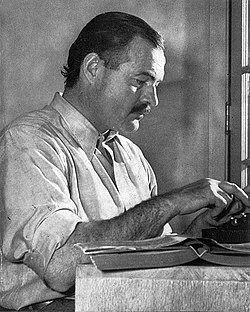Ernest Hemingway Quote
If I walked down by different streets to the Jardin du Luxembourg in the afternoon I could walk through the gardens and then go to the Musée du Luxembourg where the great paintings were that have now mostly been transferred to the Louvre and the Jeu de Paume. I went there nearly every day for the Cézannes and to see the Manets and the Monets and the other Impressionists that I had first come to know about in the Art Institute at Chicago. I was learning something from the painting of Cézanne that made writing simple true sentences far from enough to make the stories have the dimensions that I was trying to put in them. I was learning very much from him but I was not articulate enough to explain it to anyone. Besides it was a secret. But if the light was gone in the Luxembourg I would walk up through the gardens and stop in at the studio apartment where Gertrude Stein lived at 27 rue de Fleurus.
If I walked down by different streets to the Jardin du Luxembourg in the afternoon I could walk through the gardens and then go to the Musée du Luxembourg where the great paintings were that have now mostly been transferred to the Louvre and the Jeu de Paume. I went there nearly every day for the Cézannes and to see the Manets and the Monets and the other Impressionists that I had first come to know about in the Art Institute at Chicago. I was learning something from the painting of Cézanne that made writing simple true sentences far from enough to make the stories have the dimensions that I was trying to put in them. I was learning very much from him but I was not articulate enough to explain it to anyone. Besides it was a secret. But if the light was gone in the Luxembourg I would walk up through the gardens and stop in at the studio apartment where Gertrude Stein lived at 27 rue de Fleurus.
Related Quotes
About Ernest Hemingway
Hemingway was raised in Oak Park, Illinois, a suburb of Chicago. After high school, he spent six months as a reporter for The Kansas City Star before enlisting in the Red Cross. He served as an ambulance driver on the Italian Front in World War I and was seriously wounded by shrapnel in 1918. In 1921, Hemingway moved to Paris, where he worked as a foreign correspondent for the Toronto Star and was influenced by the modernist writers and artists of the "Lost Generation" expatriate community. His debut novel, The Sun Also Rises, was published in 1926. In 1928, Hemingway returned to the U.S., where he settled in Key West, Florida. His experiences during the war supplied material for his 1929 novel A Farewell to Arms.
In 1937, Hemingway went to Spain to cover the Spanish Civil War, which formed the basis for his 1940 novel For Whom the Bell Tolls, written in Havana, Cuba. During World War II, Hemingway was present with Allied troops as a journalist at the Normandy landings and the liberation of Paris. In 1952, his novel The Old Man and the Sea was published to considerable acclaim, and won the Pulitzer Prize for Fiction. On a 1954 trip to Africa, Hemingway was seriously injured in two successive plane crashes, leaving him in pain and ill health for much of the rest of his life. He committed suicide at his house in Ketchum, Idaho, in 1961.
